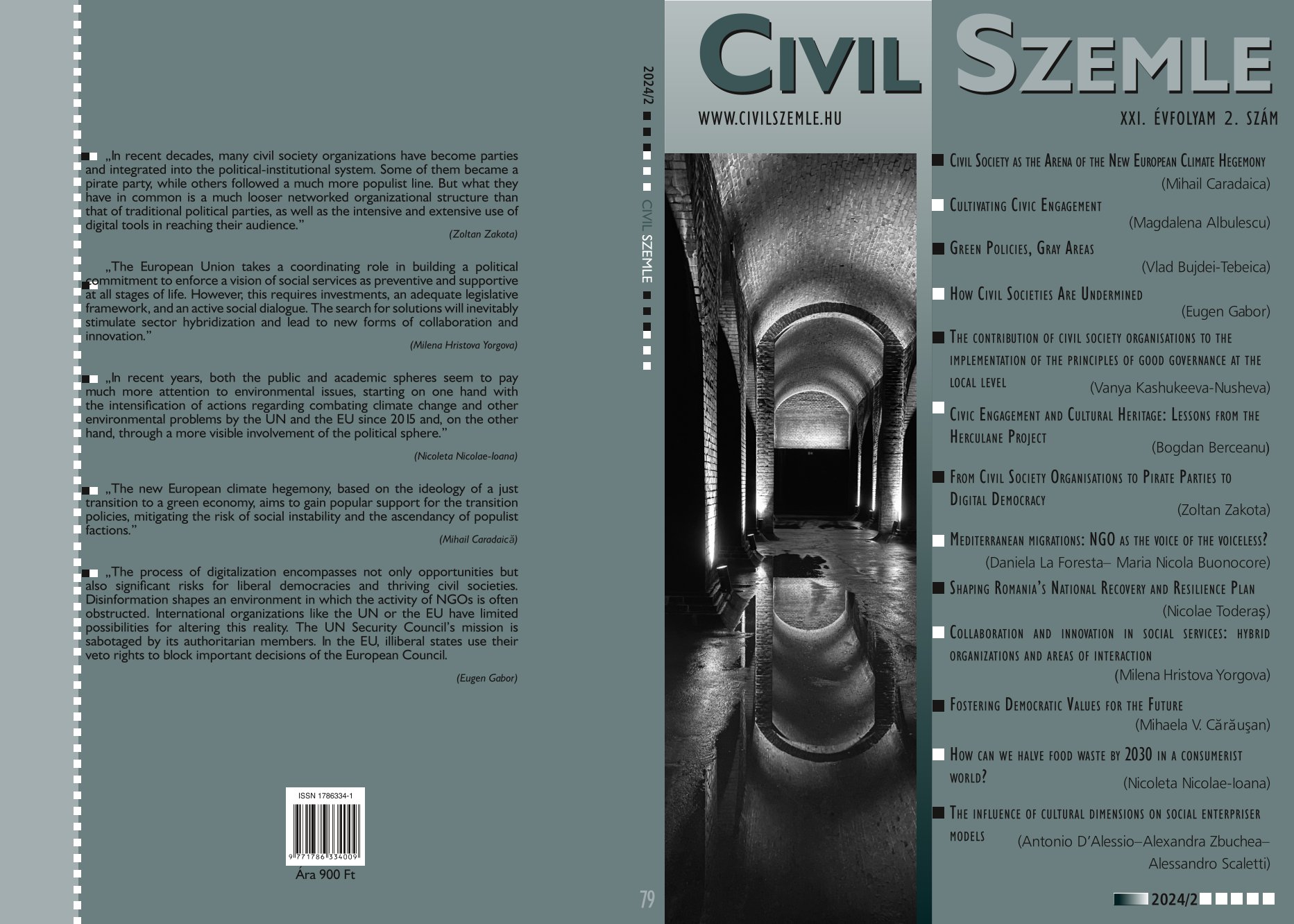Shaping Romania's National Recovery and Resilience Plan
An Analysis of the Involvement of Civil Society Organizations
Abstract
During the shaping of Romania’s National Recovery and Resilience Plan (NRRP), an environment conducive to the creation of institutional arrangements for socio-centric governance was established. However, these arrangements were not enduring and could not modify the specific path dependency of state-centric governance arrangements. This research presents and analyzes perceptions regarding the extent and way Civil Society Organizations (CSOs) were engaged in the shaping process of Romania’s NRRP. Based on semi-structured interviews with the relevant CSOs, factors that have influenced the involvement of CSOs in shaping Romania’s NRRP about other European fund programming processes, the lessons learned from this process, as well as possibilities of enhancing the current governance regime specific to European funds management were examined.
References
Bokhorst, David–Corti, Francesco (2023): ‘Governing Europe’s Recovery and Resilience Facility:
Between Discipline and Discretion.’ Government and Opposition, pp. 1–17, https://doi.org/10.1017/gov.2023.14
Capati, Andrea (2023): ‘The COVID–19 Pandemic and the Establishment of the Recovery and Resilience Facility: A “Critical Junctures” Analysis of the European Union’s Financial Assistan¬ce Regime’. Politikon, 55., pp. 19–43, https://doi.org/10.22151/politikon.55.2.
Ciot, Melania-Gabriela (2023): ‘Romanian Civil Society and the P reparation of Romania’s A cces-sion to the EU’. Civil Szemle, XX., (4.), pp. 221–242.
Dimitriu, Raluca (2022): ‘National Recovery and Resilience Plan: Romania’. Italian Labour Law E-Journal, 15., (1S.). https://doi.org/10.6092/issn.1561-8048/15673.
European Commission (2014): Commission Delegated Regulation (EU) No 240/2014 of 7 January 2014 on the European code of conduct on partnership in the framework of the European Structural and Investment Funds. Official Journal of the European Union, 74., 14.3.2014, pp. 1–7.
European Commission (20 21): Analysis of the recovery and resilience plan of Romania Accompanying the document Proposal for a Council Implementing Decision on the approval of the assessment of the recovery and resilience plan for Romania, SWD/2021/276 final.
European Parliament (2022): Report on the implementation of the Recovery and Resilience Facility. 2021/2251 (INI).
Hartwell, Christopher–Hagemejer, Jan–Pechcińska, Agnieszka–Drăgan, Gabriela–Sass, Magdolna Staehr, Karsten (2022): The Added Value of the Recovery and Resilience Facility A Prelimi¬nary Analysis of Plans from Estonia, Hungary, Poland, and Romania. European Parliament’s Committee on Economic and Monetary Affairs,
https://www.europarl.europa.eu/RegData/etudes/STUD/2022/689451/IPOL_STU(2022)689451_EN.pdf
Accessed on: 06. 04. 20 24.
Loia, Luis (2022): ‘Assessing Representative Democracy: The Need of New Mechanisms of Political
Representation.’ Perspective Politice, 15., (1–2.), pp. 5–19, https://doi.org/10.25019/perspol/22.15.1.
Matiuța, Cristina (2023): ‘Political parties rooted in civil society. The Case of the Save Romania Union (USR).’ Civil Szemle, 20., Special Issue (5.), pp. 127–142.
National Recovery and Resilience Plan, https://mfe.gov.ro/pnrr/ . Accessed on: 06. 04. 20 24.
Pollack, Mark (2018): ‘Rational Choice and Historical Institutionalism’. In: Wiener, Antje–Börzel,
Tanja–Risse Thomas: European Integration Theory. Oxford: Oxford University Press, pp. 108– 127, https://doi.org/10.1093/hepl/9780198737315.003.0006.
Regulation (EU) 2021/241 of the European Parliament and of the Council of 12 February 2021 establishing the Recovery and Resilience Facility, OJ L 57, 18.2.2021, pp. 17–75.
Toderaș, Nicolae (2023): ‘The perspectives of the public policies and programs evaluation system in Romania in the context of implementing the National Recovery and Resilience Plan’. Euro¬polity, 17., (2.), pp. 257_278, https://doi.org/10.25019/europolity.2023.17.2.9.
Vanhercke, Bart–Verdun, Amy (2021): From the European Semester to the Recovery and Resilien ce Facility Some social actors are (not) resurfacing. Working Paper 2021.13, Brussels: ETUI.
Zeitlin, Jonathan–Bokhorst, David–Eihmanis, Edgars (2023): Governing the RRF: drafting, implementing, and monitoring National Recovery and Resilience Plans as an interactive multilevel process, Foundation for European Progressive Studies. https://feps-europe.eu/wp-content/uploads/2023/06/Governance-RFF.pdf Accessed on: 15. 01. 2024.



